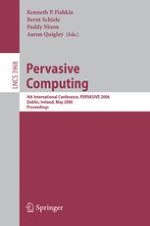2006 | Buch
Pervasive Computing
4th International Conference, PERVASIVE 2006, Dublin, Ireland, May 7-10, 2006. Proceedings
herausgegeben von: Kenneth P. Fishkin, Bernt Schiele, Paddy Nixon, Aaron Quigley
Verlag: Springer Berlin Heidelberg
Buchreihe : Lecture Notes in Computer Science
